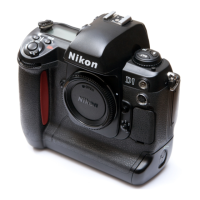125
Metering: TTL full-aperture exposure metering system with three meter-
ing modes
3D color matrix: 3D color matrix metering using 1,005-pixel CCD supported
when D-Type Nikkor lens is attached; with other lenses, color
matrix metering using 1,005-pixel CCD is supported
Center-weighted: Greatest weight (75% of total) given to a circle in the center of
the frame 8 mm in diameter
Spot: Exposure determined by 4 mm circle in center of frame (approx.
2% of frame); when a CPU Nikkor lens is attached, any of the
five focus areas can be used for spot metering
Exposure range: At ISO 100, room temperature, and with f/1.4 lens, 0–20 EV
(center-weighted and 3D color matrix metering) or 2–20 EV
(spot metering)
Metering coupling: Combined CPU and AI
Exposure compensation:
–5 to +5 EV in increments of
1
/
3
EV; exposure compensation
indicator appears in viewfinder and top control panel
Auto-exposure lock: Detected exposure locked when AE/AF lock button is pressed
Auto bracketing: Two or three exposures with compensation in increments of
1
/
3
,
1
/
2
, or 1 EV
Shutter: Combined electronic (CCD) and mechanical shutter
Speed: 30–
1
/
16,000
sec. (
1
/
3
increments), long time exposure (bulb)
Speedlight
Sync contact: X-contact only; flash synchronization at shutter speeds of
1
/
500
sec. or slower.
Flash control: (1) Automatic balanced fill-flash controlled by five-segment TTL
multi-sensor with single-component IC. If SB-28DX Speedlight
is combined with a D-Type AF-Nikkor lens, 3D multi-sensor
balanced fill-flash for D1 is used. If the SB-28DX is combined
with AI-P or AF Nikkor lens other than D-Type, multi-sensor
balanced fill-flash for D1 is used. If the SB-28DX is combined
with a non-CPU Nikkor lens, balanced TTL flash for the D1 can
be used with center-weighted metering.
(2) Auto aperture (AA) flash: supported with SB-28DX and CPU
Nikkor lenses
(3) Non-TTL auto flash: supported with SB-28, SB-27, and SB-
22s Speedlights
Flash sync modes: Front curtain (normal) sync, red-eye reduction, red-eye reduc-
tion with slow sync, slow sync, rear curtain
Ready light: Lights when flash SB-28DX, SB-28, SB-27, or SB-22s is fully
charged; blinks for three seconds after being fired at full output
Accessory shoe: Standard ISO hot-shoe contact with safety lock
Sync terminal: Standard JIS terminal with locking screw
Self timer: Electronically controlled timer, duration 2–20 seconds
Technical Notes: Specifications

